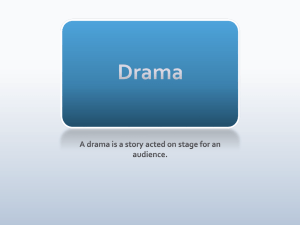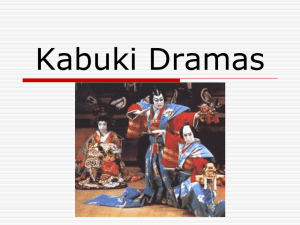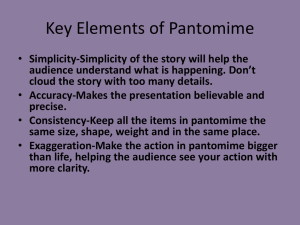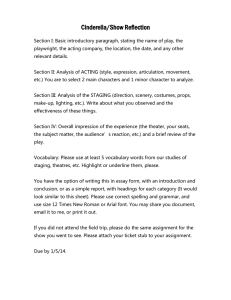Dramatic Elements
advertisement
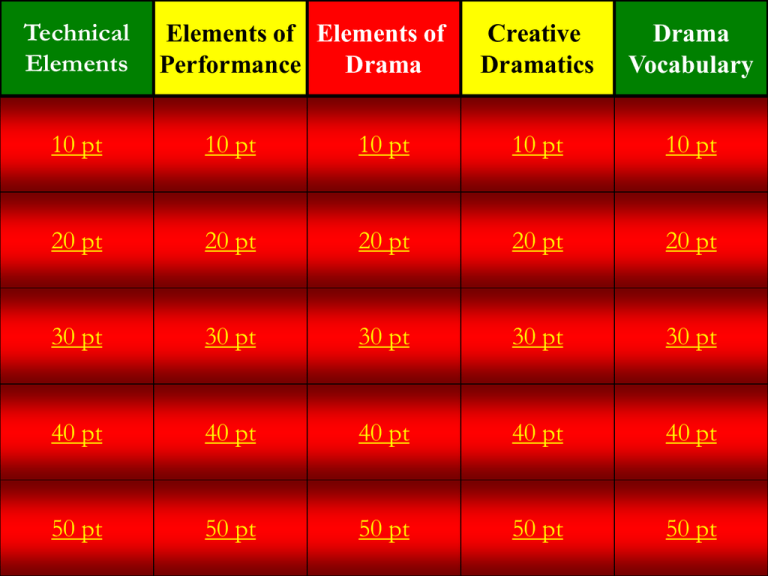
Technical Elements Elements of Elements of Performance Drama Creative Dramatics Drama Vocabulary 10 pt 10 pt 10 pt 10 pt 10 pt 20 pt 20 pt 20 pt 20 pt 20 pt 30 pt 30 pt 30 pt 30 pt 30 pt 40 pt 40 pt 40 pt 40 pt 40 pt 50 pt 50 pt 50 pt 50 pt 50 1pt What are the objects called which are placed on stage or carried or held by the actor? A.Makeup B.Costumes C.Props D.Scenery 2 What are the objects called which are placed on stage or carried or held by the actor? A.Makeup B.Costumes C.Props D.Scenery 3 What are the clothes called which actors wear on stage to help act out their characters? A.Makeup B.Costumes C.Props D.Scenery 4 What are the clothes called which actors wear on stage to help act out their characters? A.Makeup B.Costumes C.Props D.Scenery 5 Identify the painted backgrounds used to create the setting of a play. A.Makeup B.Costumes C.Props D.Scenery 6 Identify the painted backgrounds used to create the setting of a play. A.Makeup B.Costumes C.Props D.Scenery 7 Technical elements of a production include: A.Acting, speaking, gestures B.Costumes, script, and setting C.Props, costumes, sound and music D.Storyline, makeup, and script 8 Technical elements of a production include: A.Acting, speaking, gestures B.Costumes, script, and setting C.Props, costumes, sound and music D.Storyline, makeup, and script 9 Which of the following is not a technical element: A.Scenery B.Proscenium C.Movement D.Sound & Music 10 Which of the following is not a technical element: A.Scenery B.Proscenium C.Movement D.Sound & Music 11 Which of the following is NOT an element of performance? A.Nonverbal expression B.Character development C.Movement D.Speaking Style 12 Which of the following is NOT an element of performance? A.Nonverbal expression B.Character development C.Movement D.Speaking Style 13 Giving a performance without planning or preparation, and making up the actions and words as you go along, would be what kind of acting? A.Mimicry B.Improvisation C.Pantomime D.Role Playing 14 Giving a performance without planning or preparation, and making up the actions and words as you go along, would be what kind of acting? A.Mimicry B.Improvisation C.Pantomime D.Role Playing 15 An actor will use ______ to show the audience he is angry. A.Vocal expression B.Hand gestures C.Facial expressions D.All of the above 16 An actor will use ______ to show the audience he is angry. A.Vocal expression B.Hand gestures C.Facial expressions D.All of the above 17 The plot of a play must include all of the following except: A.What happens in the play B.The beginning, middle & end C.The pattern the actors follow on stage D.The sequence of events in the play 18 The plot of a play must include all of the following except: A.What happens in the play B.The beginning, middle & end C.The pattern the actors follow on stage D.The sequence of events in the play 19 When performing a DRAMA, which is the least important in playing a character? A.Scenery B.Facial expression C.Gestures D.Projection 20 When performing a DRAMA, which is the least important in playing a character? A.Scenery B.Facial expression C.Gestures D.Projection 21 A problem that creates a struggle or disagreement between characters in a play is: A.Dialogue B.Focus C.Projection D.Conflict 22 A problem that creates a struggle or disagreement between characters in a play is: A.Dialogue B.Focus C.Projection D.Conflict 23 In drama, a one-way conversation in which someone tells a lot about him or herself is know as a what? A.Dialogue B.Monologue C.Introduction D.Conflict 24 In drama, a one-way conversation in which someone tells a lot about him or herself is know as a what? A.Dialogue B.Monologue C.Introduction D.Conflict 25 In drama, what is the name for a conversation or talking between two characters in a story? A.Dialogue B.Monologue C.Introduction D.Conflict 26 In drama, what is the name for a conversation or talking between two characters in a story? A.Dialogue B.Monologue C.Introduction D.Conflict 27 A problem that creates a struggle or disagreement between characters in a play is: A.Projection B.Monologue C.Focus D.Conflict 28 A problem that creates a struggle or disagreement between characters in a play is: A.Projection B.Monologue C.Focus D.Conflict 29 In what part of the drama does an audience become aware of the setting and characters? A.Middle B.End C.Beginning D.Plot 30 In what part of the drama does an audience become aware of the setting and characters? A.Middle B.End C.Beginning D.Plot 31 The practice of imitating is called: A.Improvisation B.Monologue C.Mimicry D.Pantomime 32 The practice of imitating is called: A.Improvisation B.Monologue C.Mimicry D.Pantomime 33 Improvising movement and dialogue to put oneself in another’s place in a particular situation, often to learn about the person or situation being improvised. A.Improvisation B.Role Playing C.Storytelling D.Pantomime 34 Improvising movement and dialogue to put oneself in another’s place in a particular situation, often to learn about the person or situation being improvised. A.Improvisation B.Role Playing C.Storytelling D.Pantomime 35 When an actor acts out scenes or actions without using any words, this is called: A.Improvisation B.Role Playing C.Storytelling D.Pantomime 36 When an actor acts out scenes or actions without using any words, this is called: A.Improvisation B.Role Playing C.Storytelling D.Pantomime 37 Giving a performance without planning or preparation, and making up the actions and words as you go along, would by what kind of acting? A.Improvisation B.Role Playing C.Storytelling D.Pantomime 38 Giving a performance without planning or preparation, and making up the actions and words as you go along, would by what kind of acting? A.Improvisation B.Role Playing C.Storytelling D.Pantomime 39 Improvisation is when 2 or more actors: A.Go over their lines with each other B.Imitate an action, movement, or dialogue C.Act without a script, making it up as they go alone. D.Use movement to tell a story. 40 Improvisation is when 2 or more actors: A.Go over their lines with each other B.Imitate an action, movement, or dialogue C.Act without a script, making it up as they go alone. D.Use movement to tell a story. 41 What is the purpose of a folktale? A.To pass on tradition or culture B.To express feelings C.To celebrate an event D.To show artistic ability 42 What is the purpose of a folktale? A.To pass on tradition or culture B.To express feelings C.To celebrate an event D.To show artistic ability 43 What is the point of highest interest ina drama called? A.Climax B.Introduction C.Middle D.End 44 What is the point of highest interest ina drama called? A.Climax B.Introduction C.Middle D.End 45 The script, storyline, and the setting are examples of what element in DRAMA? A.Technical B.Literary C.Performance D.All of the above 46 The script, storyline, and the setting are examples of what element in DRAMA? A.Technical B.Literary C.Performance D.All of the above 47 The plot of a play must include all of the following except: a. Dramatic A.What happens in the play Elements B.The beginning, middle, & end b. Creative C.The pattern the actors follow on stage Dramatics D.The sequence of events in the play c. Elements of Production 48 The plot of a play must include all of the following except: A.What happens in the play B.The beginning, middle, & end C.The pattern the actors follow on stage D.The sequence of events in the play 49 Storytelling, Mimicry, Pantomime, Improvisation, and Role Playing are all: A.Creative dramatics B.Dramatic elements C.Technical elements D.Elements of performance 50 Storytelling, Mimicry, Pantomime, Improvisation, and Role Playing are all: A.Creative dramatics B.Dramatic elements C.Technical elements D.Elements of performance 51

